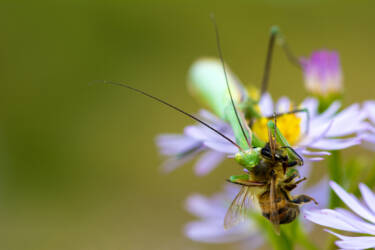8 tips for getting started with outdoor macro photography

Intrigued by macro photography but not sure where to start? Photographer Jeremy Ducrot gives us his eight top tips for getting to grips with the art of the ultra-close-up
Macro photography is extreme close-up photography, technically using a macro lens with a minimum magnification ratio of 1:1, which means the subject will appear the same size on the sensor as it does in real life. So, you can enter the world of insects and flowers, for example, with incredible detail. The beauty of this technique is you can start exploring the world of macro using either a DX or FX camera and the results are simply breath-taking. So, why wait?
Jeremy Ducrot

1.Think composition
Macro photography is all about the detail. When you’re starting out, it’s tempting to zoom in as close as you can get. When you do, though, you’ll find the results are a little underwhelming. Composition is the name of the game here, and it’s probably the hardest part of macro photography to master. Sometimes a little distance goes a long way towards bringing some background and atmosphere into your shot, which can help to spotlight your subject.
2. Understand maximum magnification
Magnification, also known as reproduction ratio, describes how closely you’ve focused on your subject, and the ratio between an object’s size on the camera sensor versus its real size. To start producing macro photographs, you first need to understand your lens’ maximum magnification. Switch to manual mode and move the focusing ring to the minimum-allowed distance at the longest focal length, if using a zoom lens. Next, look inside the viewfinder or live view and see if your subject is in focus and sharp – if not, move around until it is. When you see the right distance with a sharp focus, you’ve found your maximum reproduction ratio. All our NIKKOR lenses state their maximum magnification, too.

3. Know your macro lenses
Nikon macro lenses are known as MC lenses. MC lenses (those that can project an image of a small subject on to the sensor at a ratio of 1:1) are fantastic for bokeh, because the increased magnification creates a shallow depth of field, even when at a higher f-stop. For those on a budget, the NIKKOR Z MC 50mm f/2.8 is a fantastic prime lens that can handle an enormous number of styles and situations, from street photography and even landscapes through to true 1:1 macro shots. At the other end of the scale, the NIKKOR Z MC 105mm f/2.8 VR S is a pro-level lens for close-up work that delivers superb bokeh.
But don’t be discouraged if you don’t own a macro lens. To shoot macro style without an actual macro lens, use your zoom lens (zoom to the maximum) with manual focus set to minimum focus distance so you can get in as close as possible to the subject, and experiment from there.

4. Keep it clean (enough)
Don’t obsess over sharpness. When it comes to macro photography, it depends on what you’re shooting and why. Some scenes work better with a bit of background blur and others with one crisp, clean point of focus.
Focus stacking improves sharpness by blending multiple images taken from different focus distances: the result is f/200-grade photographs that would be otherwise impossible. This technique is incredibly handy in macro photography, where you’ll be getting up close and personal with your subjects, and things can easily fall out of your depth of field.
For a deep dive into focus stacking, check out David Leaser’s guide to focus stacking here.

5. Rise and shine
As with landscape photography, sunrise is the macro photographer’s golden hour – a time of day when the air is still cool, and the insects are still in their rest phase. As dawn breaks, expect dewy plants and flaming skies that form a spectacular backdrop for your photographs. You’ll need to set your alarm early for the best chance of capturing insects and their secret lives.
6. Get to know your local wildlife
The plants and creatures you’ll encounter will vary by season and time of day. Hit the books or browse online to find out which flora and fauna call your area home, and when the best time is to catch them.

7. Select a small aperture
To get the most out of available depth of field, select a small aperture such as f/16 or even f/22, although be aware of diffraction (a slight loss of sharpness at such apertures), particularly on smaller sensor cameras. You will find that at half-life size the depth of field you can achieve at f/22 will be only around 15 mm at best. On the other hand, you may wish to go to the other extreme and show as little sharpness as possible by opening up to full aperture such as f/2.8 or f/4. One advantage of the latter option is that any out-of-focus highlights will show as beautiful bokeh.
To extend the area in focus beyond this, you’ll need to look into focus stacking, either in-camera (if your camera supports it) or using additional software. Look in the camera menu for ‘Focus Shift’. This process combines several shots taken at different focus points to give additional detail. David Leaser’s guide to focus stacking explains this in more detail here.
8. Become a post-processing pro
There’s no right or wrong way to handle your macro photography processing. What matters is having fun with it and conveying a particular mood or feeling. And, as with any post-processing, go easy on the dials and keep colours and contrast within the realms of what’s realistic.
Uncover NIKKOR Lenses
Featured products
More in macro
Exploring abstract macro photography at home
Elevating the ordinary with focus stacking

Unlock greater creativity











